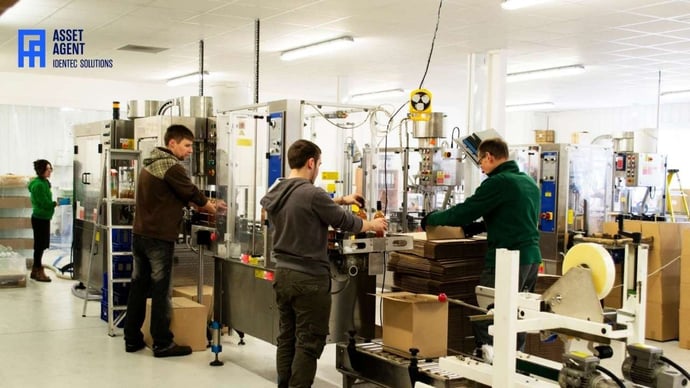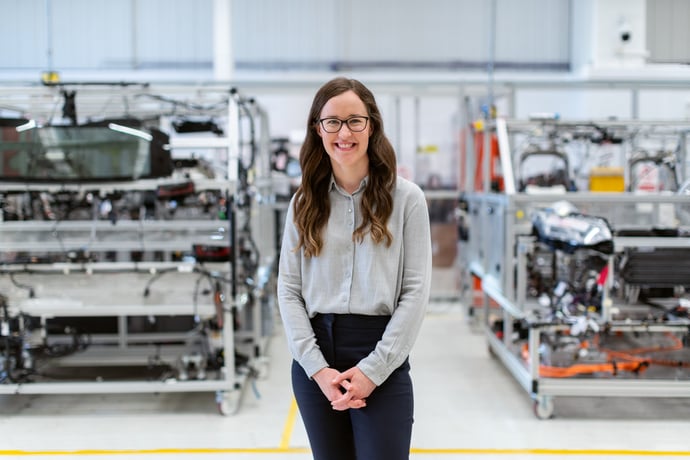Assembly Work: Station Design
| Written by Mark Buzinkay

No video selected
Select a video type in the sidebar.
Assembly Work: The U-Cell job organisation
In an assembly plant, manufacturing is typically organised using either the assembly line or assembly cell approach. Although cells generally outperform the line model, they are not always feasible for every application. Among various cell designs, the U-cell is the most widely used, with task assignments structured according to three distinct models: (1) Baton touch, (2) caravans, and (3) bucket brigades.
In the Baton-touch model, the most common approach within U-shaped cells, an operator follows a loop of tasks in the same direction as the moving workpieces. Here, the operator shifts to the next station on the same side of the cell or occasionally moves across to the opposite side. Normally, this movement involves a maximum of two crossings between the sides. However, there are some exceptions, such as with machine tools that have long cycles; these may require operators to repeatedly return to the same machine several times within a single cycle.
The Caravan approach is favoured by operators but is limited to cells with a maximum of two operators, who share the workload equally. In this model, each operator sequentially works on all jobs within the cell. At each stage, the operator retrieves the last part processed at that stage and moves it to the next machine for further processing.
The Bucket brigade, also referred to as the "bump-back system," is the third model and the only one that does not fit neatly into a work combination chart due to its flexible job assignments. This method is particularly advantageous in mass customisation environments, such as at a fast food restaurant for sandwich assembly. In the Bucket brigade model, operators are positioned from slowest to fastest. As each unit is completed in the cell, each operator takes over the next unit from their predecessor, while the first operator begins working on a new piece. This system has been observed to be self-balancing, allowing operators to naturally take on tasks that equalise the workload time across the team.
How do you Design a Station For Assembly Work?
An assembly station is the central point where materials, fixtures, tools, machines, gauges, methods, and assemblers come together to facilitate the assembly operations. Unlike machining processes, which follow linear sequences of operations, assembly processes resemble trees, where each branch represents a sequence of operations that consume materials and feed into higher-level branches. These branches all connect to the main trunk, ultimately leading to the root, which is the completed product.
When considering part supply, the assembly bill of materials (BOM) is represented as a graph rather than a strict tree. This is because a single part may be used across multiple subassemblies, and the same subassemblies can be incorporated into various final products. This interconnected structure allows for flexibility and efficiency in managing parts across different assemblies. An assembly process encompasses the following:
- A subassembly structure, focused on branches and nodes and, whenever possible, shown in graphic form.
- For each branch, a table of operations, with the following elements for each:
- A name
- Drawings, photographs, or videos
- Step instructions
- Key points
- Tools required
- Components and quantities used
- Labour required
Gathering detailed information, especially regarding labour requirements, poses a significant challenge for a production line that has yet to be established. To address this, predetermined time standards such as Methods Time Measurement (MTM)—an internationally recognised standard for work design—can be utilised. Estimating times for tasks that have not yet been performed is complex and meticulous. When production begins, the actual outcomes typically fall within a 30% range of these initial estimates.
In the subsequent process design stage, the abstract assembly tree is converted into a network of workstations. These workstations are connected by conveyance mechanisms between sequential stations and equipped with tools, fixtures, part presentation or feeding devices, and detailed work instructions. The efficiency of material flow within these designs is assessed using blueprints, where miniature models of the products are moved as if in a board game, allowing designers to visualise the assembly process. While this can sometimes be done using discrete-event simulation software, the high costs—particularly the engineering hours required to develop and fine-tune these simulation models—often make this approach impractical.
Before finalising the assembly concept, a trial line or cell is typically set up in a dedicated area, allowing for final adjustments before the line or cell is constructed for production ramp-up on the factory floor. Additionally, this trial setup serves as a training and preparation environment for operators (learn more about industrial process optimization).
Why are Logistics Essential for Assembly Work?
Ensuring that materials are available in the correct quantities, at the correct assembly stations, precisely when needed, and in a way that facilitates assembly is a critical focus in assembly processes. This contrasts with machining, where a single workpiece moves through the entire process, and logistical concerns are generally limited to managing chip disposal. Assembly designers must meticulously plan the flow of every part, tracing its path back through the entire supply chain to both internal and external suppliers. This planning process involves addressing essential questions such as:
- Should parts be provided in kits or arranged in racks positioned behind the assembly station?
- What frequency of delivery is optimal for parts to the assembly line?
- How frequently should parts be delivered to the plant overall?
- Is it necessary to include a buffer to separate internal lead times from external ones?
- What is the best way to organise ordering and deliveries for both local and distant suppliers?
In the process design phase, the manufacturer faces the decision of which parts to produce internally and which to procure from external suppliers. The primary reason for in-house production is often to maintain control over the supply chain, while outsourcing is generally driven by a need to reduce costs. However, when designing an assembly process, logistical considerations around assembly cannot be overlooked, as they play a crucial role in determining the efficiency and feasibility of the overall operation.
Assembly Work: Station Dimensions and Fixtures
The size of the product significantly influences workstation design. For small products, like cell phones or industrial saws, assembly typically occurs within a U-shaped cell, with the assembler working inside this area so that part deliveries do not disrupt the workflow. Workbenches should be compact to avoid complicating communication, logistics, and product flow, as well as to prevent wasted floor space. Additionally, there is often considerable opportunity to improve efficiency through better use of conveyors.
For medium-sized products, such as car diesel engines, the design must ensure parts can be easily and accurately positioned for assembly. Parts necessary for a single or a few products should be the only ones stored at the workstation. When this principle is not followed, stations often become cluttered with excess parts, boxes, and pallets. This scenario, though common, results in productivity losses as workers spend time searching for parts amidst clutter, work in poor lighting with limited visibility, and deal with obsolete parts scattered throughout the factory.
An ideal assembly fixture should enable the assembler to work with both hands freely, support ergonomic assembly steps, integrate seamlessly with automated equipment when necessary, and serve as a kit pallet for product-specific parts. Ideally, the fixture should also be able to hold multiple products. Fixtures used for manual assembly must travel across various stations and then return to the initial station, typically moving along an overhead or underfloor track aligned with the assembly line.
Furthermore, hand tools should be fixed to the station rather than carried by the assembler. Common tools used in assembly processes include:
- Pneumatic or electric screwdrivers and nut runners
- Wrenches and torque wrenches
- Fluid dispensers: Cleanser, adhesive, sealant or flux
- Soldering irons
- Pliers and crimping tools
- Q-tips and brushes
- Mallets and hammers
Assemblers possess the most expertise when it comes to the optimal placement of hand tools, making it essential to consult and, whenever possible, actively involve them in the decision-making process. Effective tool placement means positioning each tool within the assembler’s arm’s reach, prioritising the most frequently used tools by placing them closest. Tools should also be oriented to minimise unnecessary movement, ensuring assemblers do not need to rotate the tool 180° before use.
For large products, particularly those assembled on moving conveyors, the challenge of securing tools at stations is addressed by mounting tools on mobile fixtures. These fixtures travel alongside the product through the station and then automatically return to their starting position once the task is complete.
FAQ Assembly work
How is a U-shaped cell advantageous in assembly work?
The U-shaped cell design is beneficial because it places the assembler in a central position, allowing easy access to all necessary tools and materials within arm's reach. This arrangement enhances efficiency by minimising movement and reducing assembly time. Additionally, the U-shape supports smoother workflow transitions between tasks, improving overall productivity and making it easier to spot and resolve potential issues.
Why is tool placement so important at assembly stations?
Tool placement directly impacts the ease and speed with which assemblers can complete their tasks. Placing tools within close, convenient reach reduces unnecessary movements, while orienting tools correctly prevents the assembler from having to adjust or turn them before use. Effective tool placement not only minimises physical strain but also optimises productivity by allowing assemblers to work more quickly and efficiently.
What are the challenges in organising materials for medium and large products?
Medium and large products require careful planning to prevent workstation clutter, which can lead to reduced efficiency. For medium-sized items, the station should only hold parts for one or a few products to avoid overcrowding, which can cause delays as assemblers search for specific items. For large products, the challenge lies in ensuring tools and parts can follow the product along moving conveyors; mobile fixtures are often used here to keep tools accessible as the product moves through the assembly process.
Takeaway
Effective assembly workstation design is essential for improving productivity, ergonomics, and workflow in manufacturing. U-shaped cells, strategic tool placement, and streamlined material flow each play crucial roles in optimising assembly efficiency. Manufacturers can reduce delays and enhance assembler comfort and accuracy by considering product size, workstation layout, and logistics. For a deeper understanding of how these design principles integrate within broader production systems, explore the next article on the assembly process, where we examine the complete journey from design planning to full-scale production.
Delve deeper into one of our core topics: Real time locating system
Glossary
A soldering iron is a hand tool used to melt solder, allowing it to flow into the joint between two workpieces, typically in electronics or metalworking. It consists of a heated metal tip and an insulated handle. Soldering irons are essential for creating strong, conductive bonds in circuits. They come in various types, such as adjustable-temperature and cordless models, catering to diverse applications. (2)
Sources:
(1) Baudin M., Netland T. (2023): Introduction to Manufacturing. New York: Routledge
(2) Rathbone, D. (2021). Practical Electronics for Inventors (4th ed.). McGraw-Hill Education.
Note: This article has been updated on the 13th of January 2025

Author
Mark Buzinkay, Head of Marketing
Mark Buzinkay holds a PhD in Virtual Anthropology, a Master in Business Administration (Telecommunications Mgmt), a Master of Science in Information Management and a Master of Arts in History, Sociology and Philosophy. Mark spent most of his professional career developing and creating business ideas - from a marketing, organisational and process point of view. He is fascinated by the digital transformation of industries, especially manufacturing and logistics. Mark writes mainly about Industry 4.0, maritime logistics, process and change management, innovations onshore and offshore, and the digital transformation in general.




